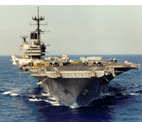CV60
Posts: 992
Joined: 10/1/2012
Status: offline

|
Revised MiG-21F-13 for comment
OVERVIEW: The MiG-21F-13 Fishbed C is a single seat, single engine, short-range, daytime/clear-weather, Mach 2.0, 2nd generation point defense interceptor. It also had a secondary ground attack capability.
DETAILS: The MiG-21F-13 Fishbed C is a delta wing design, with a circular air intake and a automatically-adjusted moveable intake cone in the nose. This design gave it excellent climbing characteristics. However, it limited the MiG-21 as a dogfighter, as any turning combat led to a rapid loss of speed. Additionally, the small space available for radar limited its ability as a fighter for anything beyond close-range combat. It was further hampered as a fighter by a short range, and the poor placement of the fuel tanks ahead of the center of gravity, making the aircraft unstable as fuel was consumed. Consequentially, a "clean" Fishbed C had an effective endurance of only 45 minutes. It's engine also suffered from fuel starvation issues in ACM engagements with less than half of its fuel remaining. The pilot also had a poor visibility forward and rearward, further limiting its use in ACM. Although it was capable of 8 G maneuvering while clean, it was limited to 6 Gs when loaded. The gunsight was incapable of tracking a target maneuvering at more than 3Gs. The MiG-21 also had maneuvering problems at all altitudes when the airspeed is below 215 KIAS and above 510 KIAS. At low speeds, the aircraft may become uncontrollable, and at high speeds longitudinal stick forces become extremely heavy. Extreme buffeting made it incapable of reaching Mach 1 below 15,000 feet. Because of this various limitations, the Soviets considered GCI essential to the use of the MIG-21 for effective attack, usually attempting to vector the aircraft to approximately a 20-degree angle from the rear of the target, and making a single high speed pass before disengaging.
The Fishbed had some positive combat characteristics. It's high thrust to weight ratio allowed it to quickly accelerate from low and medium airspeeds, although this was largely mitigated by very slow engine throttle response. Although the Fishbed bled energy in a turn, it also had a smaller turn radius than most contemporaneous U.S. fighters. It was also sturdy, reliable, and easy to maintain, and its unsophisticated design increased its combat survivability.
The aircraft was powered by a Tumansky R-11F-300 turbojet engine, producing 12675 lb of thrust. The design cruising speed is 478 knots.
The Fishbed C was armed with two rear-aspect only R-3S/AA-2 ATOLL IR missiles and an internal 30mm cannon and 60 rounds of ammunition. Its radar was the short-range SRD-5M Kvant (Quantum) ranging radar to help target its weapons.
NOTES: IOC: 1961. An estimated +10,000 MiG-21s built, the most of any modern jet aircraft. Some sources give 30 round capacity for the 30mm cannon.
SOURCE: Mladenov, Alexander. Soviet Cold War Fighters. Fonthill Media, 2017, (Kindel ed., locations 1492; "[1.0] MiG-21 Single-Seat Variants." AirVectors. Accessed January 7, 2022. https://www.airvectors.net/avmig21_1.html#m2. ; "The MiG-21 Page - Performance Data." Imprimante Si Copiatoare, Produse IT: Xerox, Brother, Cisco, Microsoft - Top Edge Engineering. Accessed January 7, 2022. https://www.topedge.com/panels/aircraft/sites/kraft/data.htm. ; Images, Skytamer. "Mikoyan-Gurevich MiG-21F-13 Fishbed E." Accessed January 8, 2022. https://www.skytamer.com/MiG-21F-13.html ; Pike, John. "MiG-21 / J-7 FISHBED / YF-110." GlobalSecurity.org. Last modified 10, 2021. https://www.globalsecurity.org/military/world/russia/mig-21.htm; DIA, HAVE DOUGHNUT(U)-TACTICAL, FTD-CR-20-13-69 Vol. II (1 August 1969), pgs 1-6 to 1-7. https://theaviationist.com/wp-content/uploads/2013/11/havedoughnut.pdf
|
 Printable Version
Printable Version












 New Messages
New Messages No New Messages
No New Messages Hot Topic w/ New Messages
Hot Topic w/ New Messages Hot Topic w/o New Messages
Hot Topic w/o New Messages Locked w/ New Messages
Locked w/ New Messages Locked w/o New Messages
Locked w/o New Messages Post New Thread
Post New Thread